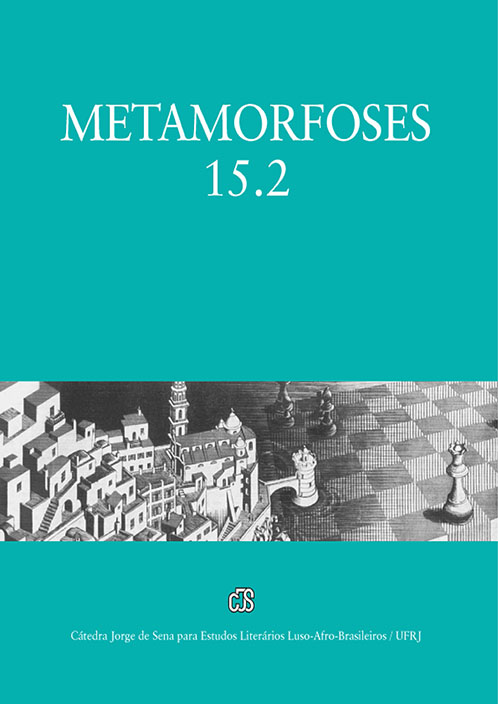Travel around the world: a reading proposal – between Portugal and Brazil – for the promotion of interculturality
DOI:
https://doi.org/10.35520/metamorfoses.2018.v15n2a18476Keywords:
picturebook, reading, world, diversity, interculturalityAbstract
This text aims to present an analysis of three picturebooks from different countries (Portugal, Brazil and France) that have in common the depiction of the variety of the world, in terms of geographic and cultural diversity. We intend to propose reading activities that can be performed with children of the 1st cycle of Primary Education (Portugal) and first segment of Primary Education (Brazil), with a view to promoting intercultural awareness. By presenting a non-traditional narrative structure, the three picturebooks under analysis configure a typology that includes aspects of the portfolio picturebook (RAMOS, 2011), and of the book-game (SILVA, 2017; 2016), challenging readers to do combine different kinds of information. Built around the topic of variety and diversity in the world, understood as a global space shared by humanity, they are forms of appreciation of plurality and difference, inviting the discovery of other spaces and cultures.
References
Corpus
BRENMAN, Ilan; KARSTEN, Guilherme. Agora! São Paulo: SESI-SP Editora, 2017.
MARTINS, Isabel Minhós; CARVALHO, Bernardo. O mundo num segundo. Oeiras: Planeta Tangerina, 2008.
______. ______. 2. ed. Carcavelos: Planeta Tangerina, 2013.
______. ______. São Paulo: Peirópolis, 2013.
PERARNAU, Chloé. A Orquestra: uma volta ao mundo à procura dos músicos. Trad. Isabel Minhós Martins. Carcavelos: Planeta Tangerina, 2018.
Estudos
BAVIDGE, Jenny. Stories in space: the geographies of children's literature, Children's Geographies. v. 4, n. 3, p. 319-330, dez. 2006. DOI: 10.1080/14733280601005682.
BRASIL. Diretrizes Curriculares Nacionais Gerais da Educação Básica. Brasília: MEC/SEB/DICEI, 2013. p. 102-104.
BRASIL; SECRETARIA DE EDUCAÇÃO FUNDAMENTAL. Parâmetros curriculares nacionais: história, geografia. Brasília: MEC/SEF, 1997.
CLARKE, Alasdair D. F.; ELSNER, Micha; ROHDE, Hannah. Where's Wally: the influence of visual salience on referring expression generation. Frontiers in Psychology. v. 4, art. 329, jun. 2013. DOI: 10.3389/fpsyg.2013.00329. Disponível em: <https://www.frontiersin.org/articles/10.3389/fpsyg.2013.00329/full>. Acesso em: 10 mar. 2018.
COLOMER, Teresa; FITTIPALDI, Martina (ed.). La literatura que acoge: Inmigración y lectura de álbumes. Caracas: Banco del Libro, 2012.
DEPARTAMENTO DE EDUCAÇÃO BÁSICA (ed.). Organização curricular e programas, 4. ed. Mem Martins: Ministério da Educação, 2004. Disponível em: <http://www.dge.mec.pt/sites/default/files/Basico/Metas/Estudo_Meio/eb_em_programa_1c.pdf>. Acesso em: 2 mai. 2018.
DOWHOWER, S. Wordless books: promise and possibilities, a genre comes of age. In: CAMPERELL, K.; HAYES, B. L.; TELFER, R. (eds.). Promises, Progress and Possibilities: Perspectives of Literacy Progression. 17. Dahlonega: American Reading Forum, 1997. p. 57-79.
FROUILLOU, L. Les albums pour enfants et les geÌographies de l'enfance: l'exemple des repreÌsentations de la maison. Carnets de geÌographes, 3, p. 1-8, 2011. Disponível em: <http://www.carnetsdegeographes.org/PDF/Lectures_03_02_Frouillou.pdf>. Acesso em: 26 mar. 2018.
KÜMMERLING-MEIBAUER, Bettina. From baby books to picturebooks for adults: european picturebooks in the new millennium. Word & Image, v. 31, n.3, p. 249-264, 2015. DOI: 10.1080/02666286.2015.1032519.
MEUNIER, C. Quand les albums parlent d'Espace: espaces et spatialités dans les albums pour enfants. PhD Thesis. Lyon: Ecole Normale Supérieure de Lyon, 2014. Disponível em: <https://tel.archives-ouvertes.fr/tel-01127003/file/2014ENSL0964.pdf>. Acesso em 26 mar. 2018.
NIKOLAJEVA, Maria; SCOTT, Carole. Livro ilustrado: palavras e imagens. Trad. Cid Knipel. São Paulo: Cosac Naify, 2011.
RAMOS, Ana Margarida. Apontamentos para uma poética do álbum contemporâneo. In: ROIG RECHOU, Blanca-Ana, SOTO LÓPEZ, Isabel; NEIRA RODRÍGUEZ, Marta (coord.). O Álbum na Literatura Infantil e Xuvenil (2000-2010). Vigo: Edicións Xerais de Galicia, 2011. p. 13-40.
SANTAELLA, Lucia. Matrizes da linguagem e pensamento: sonora, visual, verbal: aplicações na hipermídia. 3. ed. São Paulo: Iluminuras: FAPESP, 2009.
SILVA, Sara Reis da. Play in narratives for children: on the “rules” of a new fiction. In: RAMOS, Ana Margarida; MOURÃO, Sandie; CORTEZ, Maria Teresa (ed.). Fractures and disruptions in Children's Literature. Newcastle upon Tyne: Cambridge Scholars, 2017. p. 246-261.
______. O livro-jogo na literatura para a infância: brincar às/com as histórias. CONFIA - Conferência internacional em ilustração e animação. Barcelos: IPCA, p. 426-431, 2016. Disponível em: <http://repositorium.sdum.uminho.pt/handle/1822/42177>. Acesso em: 6 abr. 2018.
SIPE, Lawrence R.; PANTALEO, Sylvia. Postmodern picturebooks: play, parody, and self-referentiality. New York: Routledge, 2008.
STEPHENS, John. Advocating multiculturalism: migrants in Australian children's literature after 1972. Children's Literature Association Quarterly, v. 15, n. 4, 1990, p. 180-85.
Downloads
Published
Issue
Section
License
Autores que publicam nesta revista concordam com os seguintes termos:
- Autores mantêm os direitos autorais e concedem à revista o direito de primeira publicação, com o trabalho simultaneamente licenciado sob a Licença Creative Commons Attribution que permite o compartilhamento do trabalho com reconhecimento da autoria e publicação inicial nesta revista.
- Autores têm autorização para assumir contratos adicionais separadamente, para distribuição não-exclusiva da versão do trabalho publicada nesta revista (ex.: publicar em repositório institucional ou como capítulo de livro), com reconhecimento de autoria e publicação inicial nesta revista.
- Autores têm permissão e são estimulados a publicar e distribuir seu trabalho online (ex.: em repositórios institucionais ou na sua página pessoal) a qualquer ponto antes ou durante o processo editorial, já que isso pode gerar alterações produtivas, bem como aumentar o impacto e a citação do trabalho publicado (Veja O Efeito do Acesso Livre).

